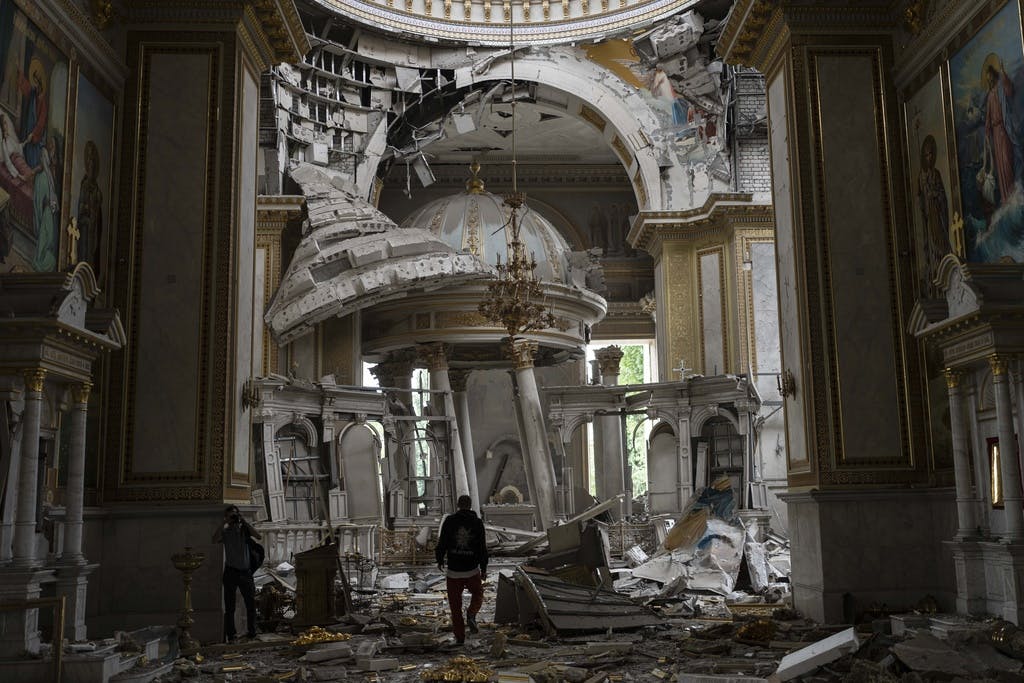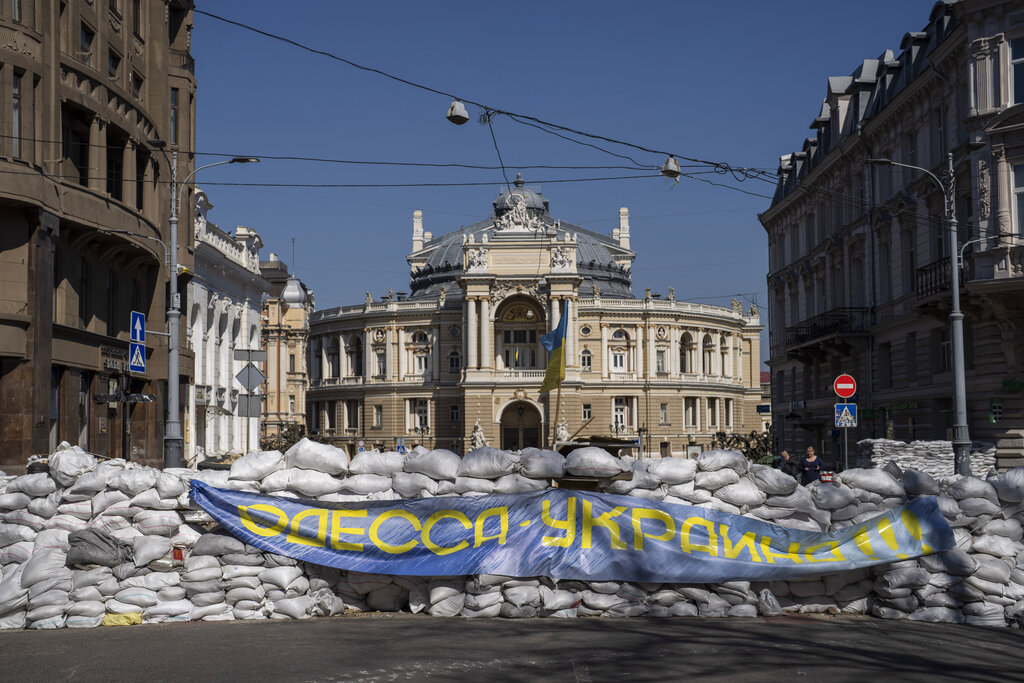As Russia Wages War on Ukraine’s Culture, Kyiv Turns To Its Own Monuments Men — With a Twist
A campaign to prosecute looters of art and destroyers of culture is being organized amid the destruction wreaked by war.

Faced with Russia’s looting of museums and destruction of churches, Ukraine is setting up its own Monuments Men – with a twist. Similar to the Allies’ World War II unit, Ukraine’s men and women are working to catalog and repatriate stolen art. In addition, this new unit of Ukraine’s Territorial Defense Forces are gathering evidence to prosecute Russian military looters and vandals.
It will be a big job. In the biggest cultural destruction Europe has seen since 1945, the United Nations Educational, Scientific and Cultural Organization’s latest tally pegs the two-year toll at damage to 343 sites — 127 churches, 151 historic buildings, 31 museums, 19 monuments, 14 libraries, and one archive. Ukraine’s Culture Ministry says 1,189 cultural buildings have been damaged or destroyed.
Some buildings fall victim to the fog of war. However, others are targets for deliberate attacks on Ukrainian culture and identity. On January 1, the birthday of Ukrainian nationalist Stepan Bandera, a Russian rocket flew over 500 miles to western Ukraine and crashed through the roof of the university where he studied in 1928.
Almost simultaneously, another rocket blew up a nearby house museum dedicated to the leader of the Ukrainian Insurgent Army in the 1940s, Roman Shukhevych. In the post-Soviet era, the “Hero of Ukraine” honor was bestowed on both men. Of the attacks, Lviv’s mayor, Andriy Sadovyi, writes on Telegram: “War for our history.”
“This is also the heritage war,” the director of Kyiv’s Maidan Museum, Ihor Poshyvailo, said recently in a Zoom call with American historians. “It’s a war against our memory, historical memory. Against our identity. Against our culture. And, of course, against our future.”

The Mystetskyi Arsenal cultural center director, Olesia Ostrovska-Liuta, joined the Zoom and said: “This Russian war in Ukraine is very tightly connected to culture. The basic assumption which lies beneath this assault is that Ukraine should not exist as a separate phenomenon with its own political agency. Any Ukrainian otherness from Russia should be erased. It is genocidal in its attempt and in its action … culture is in the very core of this war.”
A report for the European Union Advisory Mission Ukraine found that Russia’s military has intentionally targeted Ukrainian cultural property. In Odessa, missiles hit two landmarks — the city’s largest church and National Fine Arts Museum. Both are in the city core.
Last year, Unesco declared the area an endangered World Heritage Site. “It is clear that Russia is attacking sites that are central to Ukraine’s identity,” Atlantic Council program assistant Mercedes Sapuppo says in a telephone interview about her research into the Kremlin’s campaign.
At least 25 Ukrainian museums have been looted, a Russian military practice encouraged under the Bolsheviks. This was systematized by the Red Army in occupied Germany and Eastern Europe at the end of World War II.
At Melitopol, a city under Russian occupation for two years, 1,841 items have been stolen from the Museum of Local Lore, including 302 gold objects. At Kherson in October 2022, as Ukrainian forces approached, Russian soldiers parked several school buses next to the Regional Art Museum.
They moved 10,000 paintings and objects across the Dnipro River to Simferopol, capital of Russia-controlled Crimea. In an interview with Radio Free Europe’s Krym.Realii news site, the director of the Central Museum of Tavrida, Andrei Malgin, confirmed that many of the Kherson objects are now in his museum.
“We were aware that the fighting in Kherson could start any moment. I believe that attempts to save these paintings are justified,” he said, referring to what turned out to be Ukraine’s largely bloodless liberation of Kherson. “These paintings aren’t ours — we clearly understand that. We don’t have intentions to declare that they will remain with us or that we will exhibit them in the future. We only keep them.”
Last summer, the EU and Switzerland imposed sanctions on Mr. Malgin. Over the years, Russia has had a poor track record of returning stolen art. According to “Stolen Treasures,” a study posted last September by Texty, a Ukrainian news organization, two of Russia’s biggest museums — Saint Petersburg’s State Hermitage Museum and Moscow’s State Historical Museum — hold more than 110,000 artifacts that were taken over the centuries from what is now modern-day Ukraine.
Ukrainian researcher Serhii Kot believes the number is higher. He suspects that the museums’ online catalogs do not post photos of many items in order to obscure their provenance. To catch pieces on the international art market, Ukraine cooperates with such international organizations as the Art Loss Register, a London-based company with the world’s largest database of stolen artworks.
“Everyone in the art market is on the alert. Every auction house that sees art from Ukraine will start asking a lot of questions,” Art Loss Register’s chief advisor James Ratcliffe tells Ukraine’s Zaborona news site in an article headlined: “The Biggest Heist Since the Nazis: How Ukraine Searches for Stolen Art.” Mr. Ratliffe adds that “our organization has already registered more than 2,000 items from Ukraine that have been stolen, including avant-garde paintings from the Kherson Art Museum and Scythian gold from Melitopol.”
Some of Russia’s looting has a clear political goal. The Foreign Intelligence Service director, Sergei Naryshkin, a close associate of President Vladimir Putin, also heads the Russian Historical Society. Soon after Russia’s invasion of Ukraine, the society set up an “inter-museum working group” that focused on occupied parts of Ukraine. The goal was to “to show the historically inseparable connection of the region with Russia,” according to society documents.
Society agents have collected 4,000 historical objects from occupied areas allowing the group to mount four exhibitions in Russia “to show the historically inseparable connection of the region with Russia,” a society representative at occupied Luhansk, Artyom Rubchenko briefed Mr. Putin in November 2022.
Although the war seems far from over, reconstruction help is on the way. Last month, Italy and Unesco signed an agreement to provide $540,000 towards restoration of the roof of Odessa’s Transfiguration Cathedral. France will provide reconstruction aid to Odessa, sister city to Marseille, French Special Envoy for Ukraine’s Relief and Reconstruction of Ukraine Pierre Heilbronn told reporters after a trip to Odessa last month. America’s Department of State is spending $7 million to support Ukraine’s cultural heritage protection efforts.
Meanwhile, the culture war between Russia and Ukraine continues unabated. Implementing a Tsarist-era decree that the Ukrainian language “never existed, does not exist, and shall not exist,” Russian soldiers empty libraries of Ukrainian language books and burn them. In public squares, Russian administrators re-erect statues to Lenin. In turn, Ukrainian cities remove statues to Russian poet Alexander Pushkin.

